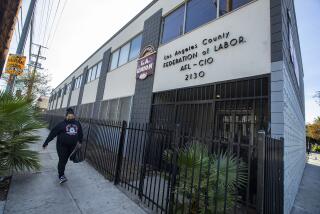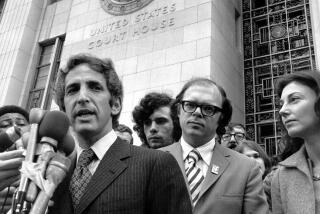R. Bolt, 90; Studied Nixon Tape
- Share via
Richard H. Bolt, an acoustics expert whose findings on a mysterious 18-minute gap in a crucial Watergate tape intensified pressure on the Nixon White House, has died. He was 90.
He had Alzheimer’s disease and died Jan. 13 at a nursing home in Rochester, N.Y.
Bolt formed a small consulting firm in Cambridge, Mass., in 1948 when he was hired to design the acoustics for the grand hall of the U.N. building in New York City.
Bolt, Beranek and Newman, later BBN Corp., rose to the top of its field primarily by designing acoustics for schools and businesses. It rarely accepted forensic work.
But in 1973, Bolt was one of six experts chosen jointly by the White House and the special prosecutor’s office to examine a tape made June 20, 1972, three days after the infamous break-in at the Democratic National Headquarters in the Washington office building called Watergate.
According to handwritten notes by President Nixon’s then-chief of staff, H.R. “Bob” Haldeman, the tape contained a conversation between the two men in which Nixon ordered a public relations offensive to counteract negative publicity from the break-in. Reporters had questioned why the Watergate burglars had phone numbers to the White House.
When investigators examined the tape, that part of the Nixon-Haldeman exchange was missing. The only mention of Watergate in the conversation apparently had been erased.
Was the erasure “caused by accident,” as U.S. District Judge John J. Sirica, who presided over the Watergate case, put it, “or was it deliberately done?”
Accidental, the White House said. Nixon’s personal secretary, Rose Mary Woods, testified that she had stopped transcribing the tape to answer a phone and that she must have stepped on the wrong pedal and pressed record when she meant to press stop. She insisted, however, that she had taken no more than five minutes to handle the phone call.
But Alexander Haig, who succeeded Haldeman as Nixon’s top aide, said women that often lose track of time on the phone and that Woods was probably responsible for the whole gap.
What Bolt and the other technical experts found cast serious doubt on the White House’s explanation.
After coating the tape with a magnetic fluid, the experts examined it for minute markings made by the operation of the recording machine. During two months of study, they found what they called the “quartet signature”--four tiny lines, each less than a millimeter high--made by the Uher 2000 tape recorder every time erasing was halted. There were five such magnetic “stop” signatures on the 18-minute length of tape. Also found were markings that showed nine starts to the erasures.
What this meant, the experts said in testimony presented in January 1974, was that the 18-minute gap was the result of at least five and as many as nine separate attempts to erase and rerecord. That contradicted the notion that it was caused by one long, mistaken press of a pedal.
Whether the obliterations were deliberate, as congressional investigators believed, or a mistake, as the White House asserted, could not be determined. But when Bolt, who headed the expert panel, was asked whether the erasure could be an accident, he said it would have to be an accident that was committed at least five times in 18 minutes.
“Now, if you want to say a monkey jumped up and down on the keys, or that stones fell on them nine times, fine,” he said later.
Most in Washington quickly understood what the sound analysis meant.
“This is the most serious single bit of evidence to date,” Rep. John B. Anderson of Illinois, then the leader of the House Republican Conference, told the Washington Post after the experts’ findings were disclosed. Echoing the sentiments of other influential Republicans, he added, “The theory that there has been a conscious effort to conceal evidence is no longer a theory.”
Nixon left office seven months later.
Bolt, the son of an American medical missionary, was born in Beijing. He attended UC Berkeley, earning a bachelor’s degree in architecture in 1933 and a master’s degree in physics in 1937. After doctoral work in acoustics at UCLA, he earned a doctorate from Berkeley in 1939. He joined MIT as a physics fellow, later rising to professor of acoustics. During World War II, he helped the Navy develop methods for using sound to detect submarines.
After the war, he returned to MIT and headed its acoustics lab. When the United Nations approached him to design the acoustics for the General Assembly Hall, he realized he needed help and recruited MIT colleague Leo Beranek. Later, former student Robert Newman joined them, forming the partnership that became BBN.
Described as a charming and irrepressibly enthusiastic man, Bolt “was not particularly interested in business administration, and preferred to take part in national activities,” Beranek said. His posts included principal consultant to the National Institutes of Health and associate director of the National Science Foundation. He also was a fellow of the Center for the Advanced Study of Behavioral Sciences at Stanford University.
Bolt retired after 23 years as chairman of BBN Corp. in 1976, just as the company was making a name for itself as a pioneer of the cyber age. BBN scientists are credited with helping build the ARPANET, the precursor of the Internet, sending the first e-mail and sparking the use of the @ symbol in e-mail addresses. Now called BBN Technologies, the company was sold in 1997 and is a division of Verizon.
After Bolt put the firm in the national spotlight with his participation in the Watergate case, BBN was hired to analyze a sound recording of the gunshots fired on John F. Kennedy’s motorcade in Dallas in 1963.
The company concluded that a fourth shot may have been fired from the so-called grassy knoll of Dealey Plaza, which supported theories that a second gunman was involved.
Bolt is survived by two daughters, a son, seven grandchildren and eight great-grandchildren.
More to Read
Sign up for Essential California
The most important California stories and recommendations in your inbox every morning.
You may occasionally receive promotional content from the Los Angeles Times.











